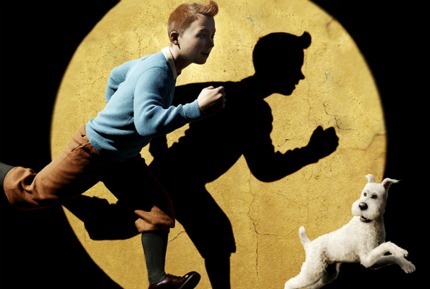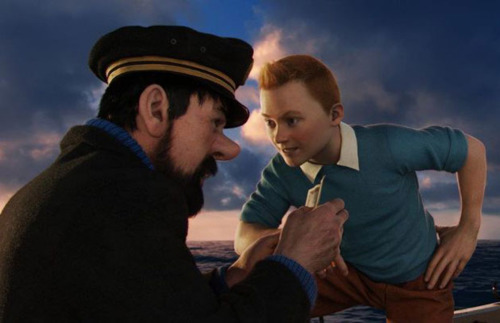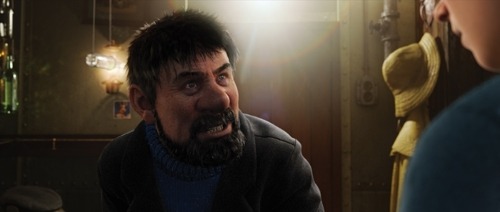Tintin is an interesting property indeed. It’s one that, even though people know about it, isn’t all that popular in North America. Or at least, not nearly as popular as it is in Europe. I admit, if I didn’t take French classes as a child, my knowledge of this character would have been almost non existent. And yet, here we are! With a high budget Hollywood adaptation of the property done by, arguably, the poster director for American blockbuster cinema, Steven Spielberg. So how did that happen?

Well, let’s go back in time to 1981, when the first Indiana Jones film, Raiders of the Lost Ark, was released. The adventure flick, inspired by the pulp adventure serials that Spielberg loved as a kid, was receiving excellent reviews, but one in particular compared the film to Tintin. Curious, Spielberg searched for the books, and even though he didn’t understand the language they were in, he became a fan. Likewise, Tintin creator Hergé became a fan of Spielberg’s work. The fit between source material and director seemed almost made for each other, and indeed this film works because you can tell Spielberg’s having fun with it. He’s in his element.
The story isn’t life changing, or deep, or anything like that. But it is a family friendly adventure done right. It’s a basic globe trotting treasure hunt wrapped in a thin mystery with plenty of memorable characters and superbly planned and executed scenes of action, chases and slapstick. In other words: it’s just plain fun! The sets are extravagant and varied, the action is creatively choreographed, and even though the movie is still family friendly it never feels like anything is dumbed down to make things seem “safer.” The enemies are still a threat and very dangerous, and Captain Haddock’s trademark alcoholism is in full effect.

Speaking of the characters let’s talk about them, because while the plot is a great excuse for moving from one excellent chase scene to the next, it’s these classic characters that will stick with you after the credits roll. The most forgettable of the bunch actually being our titular character. Tintin (played by Jamie Bell) probably wins the award for being the coolest square that ever lived. He’s an ambitious journalist who has an interesting mix of curiosity and bad luck which leads him into some very dangerous situations. But aside from having frequent full-on conversations with his dog, Snowy, Tintin isn’t a very flawed character. And while it’s nice to see a bright and optimistic action hero for a change, it doesn’t really make him all that interesting. The people Tintin does surround himself with, however, are a blast! Nick Frost and Simon Pegg are a true joy as the bumbling inspectors, Thomson and Thompson, but the true star of this film, and indeed the force that carries the plot along to its conclusion, is Andy Serkis as Captain Haddock. The drunken Captain is the only one who actually goes though a true story arc, trying to do right by his family’s name. Serkis’ amazing physicality brings so much nuances to the character that it only furthers my belief that Serkis was born to live inside of a motion capture suit.

Which brings us to the elephant in the room, and the most controversial part of this movie: the fact that it’s a mostly motion captured film. As the story goes, Spielberg went to Peter Jackson (who ended up producing the flick) to get his VFX company, Weta Digital, to create the CG for the film, including a CG Snowy. Jackson, being a longtime fan of Tintin, suggested that a fully animated version might be truer to the source material. The two settled on a motion capture performance from the actors, which allowed the film to be animated, but also allowed Spielberg to direct the actors in the same way that he’s used to for his live action films.
My thoughts on mo-cap animation is truly mixed. Part of me loves how you’re able to translate a performer’s action into a stylized and animated world, but part of me knows that the technology still isn’t fully here yet, resulting is some shots that just falls flat of looking realistic and as a result breaks the illusion completely (otherwise known as the uncanny valley effect.) That being said, while the tech still isn’t perfect yet, Tintin is the best example of a mo-cap animated film to date. The source material is so cartoony and fun, that a live action cast would still need heavy CG (like an animated Snowy) and instead of having CG bits stick out like a sore thumb (which I like to call the Garfield effect,) I’m glad they went this route and did it fully animated. It led to some great comedic moments which I felt would only work in an animated world, as well as an amazing “one shot” chase scene down a mountain, which can only be seen to be believed.
What does bug me a little is the design choice, having the character’s faces still look vaguely realistic. I would have preferred the characters to look a little more stylized like they do in the books, as characters who are more stylized like Haddock and the Thompsons are a lot more fun to look at then the eerily baby-faced Tintin. But that might just be a case of personal taste. And to those who wanted this film perfectly in Hergé’s style, we already had the Tintin TV show like that, so I’m glad they at least tried something new.

All in all, Spielberg’s first animated project is a wonderful whirlwind of an adventure which truly harkens back to the olden days of Indiana Jones…but funnier. The set pieces are a joy to behold, and the pacing is so perfect that as soon as you want another dose of action, the film will gladly oblige. If you’re looking for a wholesome adventure that doesn’t skimp on the production value, check it out. And if you’re not familiar with these characters, there’s no better time then now to get acquainted.
4/5
- Moo
No comments:
Post a Comment